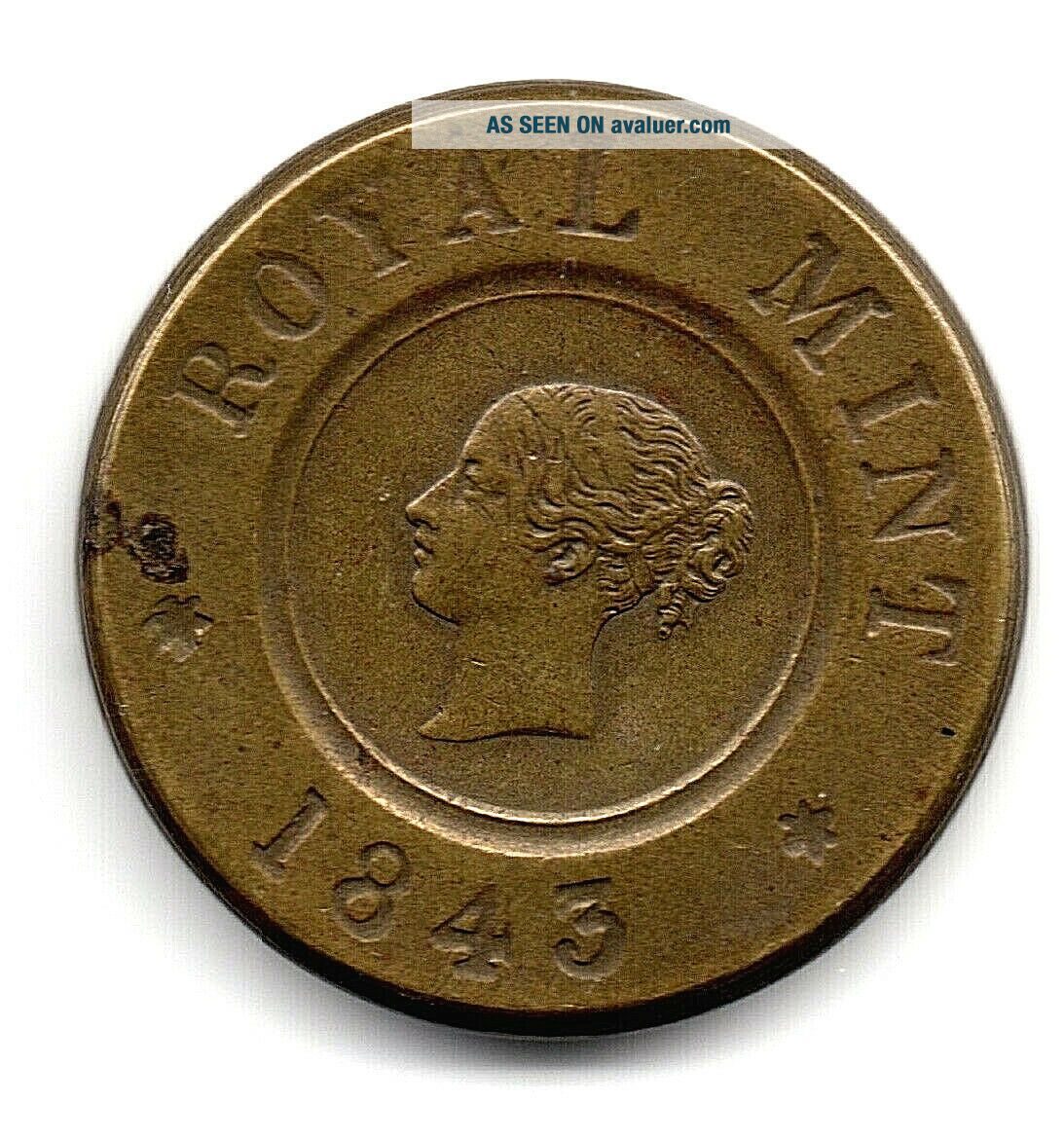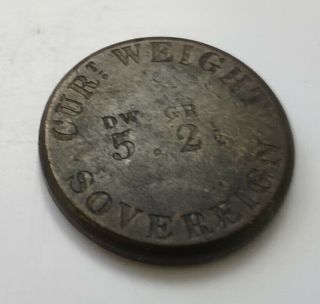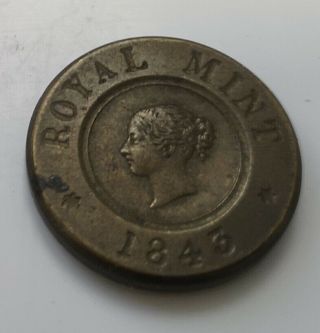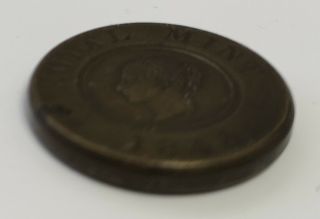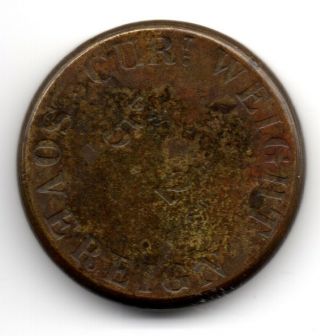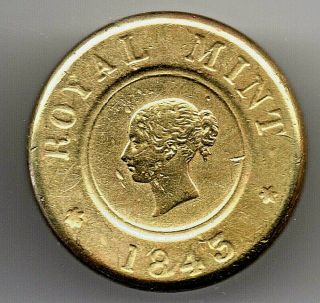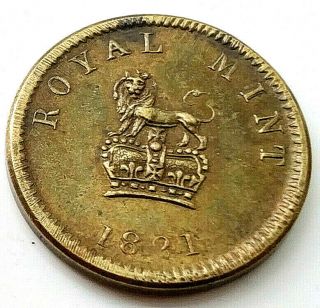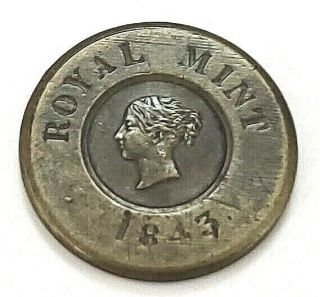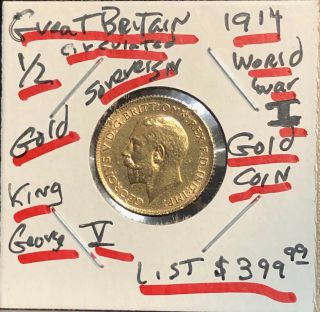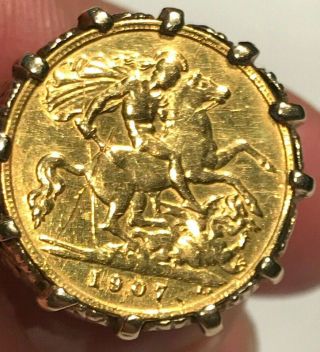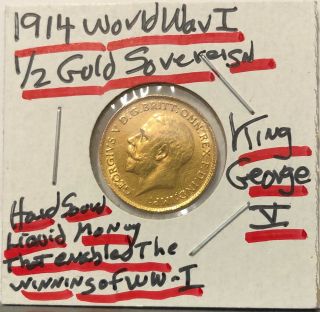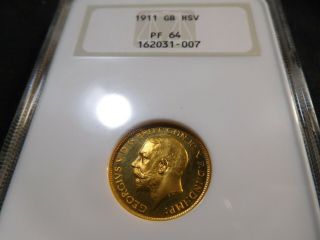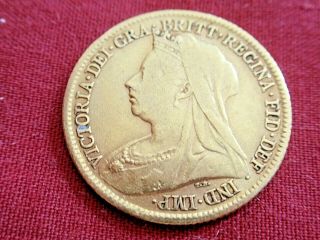1843 Half Sovereign Weight Gold Lustre Old Victorian Royal Lion Crown Coin
Item History & Price
1843 Sovereign Weight
One Hundred and Seventy Six Year Old Sovereign Weight
Made of Brass with a Golden Lustre
Has a Lion and Crown Symbols with the words "Royal Mint" & the Year it was produced 1843
The Back has the words "Curt Weight"and "Half Sovereign" & the Number 5.2 1/2
Weights the same weight a a half sovereign
In Good Condition given it is almost 200 years old
Starting at one Penny...With No Reserve..I...f your the only bidder you win it for 1p....Grab a Bargain!!!!
Would make an Excellent Lucky Charm or Collectible Keepsake Souvenir
I will have a lot of Old Coins items on Ebay so please CLICK HERE TO VISIT MY SHOP
Bid with Confidence - Check My 100% Positive Feedback from over 15, 000 Satisfied CustomersI have over 10 years of Ebay Selling Experience - So Why Not Treat Yourself?
I have got married recently and need to raise funds to meet the costs also we are planning to move into a house together
I always combined postage on multiple items so why not > Check out my other items!
All Payment Methods in All Major Currencies Accepted. All Items Sent out within 24 hours of Receiving Payment. Overseas Bidders Please Note Surface Mail Delivery Times > Western Europe takes up to 2 weeks, Eastern Europe up to 5 weeks, North America up to 6 weeks, South America, Africa and Asia up to 8 weeks and Australasia up to 12 weeksFor that Interesting Conversational Piece, A Birthday Present, Christmas Gift, A Comical Item to Cheer Someone Up or That Unique Perfect Gift for the Person Who has Everything....You Know Where to Look for a Bargain!Please Take a Moment Click Here to Check Out My Other items*** Please Do Not Click Here ***Click Here to Add me to Your List of Favourite SellersIf You Have any Questions Please Mesage me thru ebay and I Will Reply ASAPThanks for Looking and Best of Luck with the Bidding!! The Countries I Send to Include Afghanistan * Albania * Algeria * American Samoa (US) * Andorra * Angola * Anguilla (GB) * Antigua and Barbuda * Argentina * Armenia * Aruba (NL) * Australia * Austria * Azerbaijan * Bahamas * Bahrain * Bangladesh * Barbados * Belarus * Belgium * Belize * Benin * Bermuda (GB) * Bhutan * Bolivia * Bonaire (NL) * Bosnia and Herzegovina * Botswana * Bouvet Island (NO) * Brazil * British Indian Ocean Territory (GB) * British Virgin Islands (GB) * Brunei * Bulgaria * Burkina Faso * Burundi * Cambodia * Cameroon * Canada * Cape Verde * Cayman Islands (GB) * Central African Republic * Chad * Chile * China * Christmas Island (AU) * Cocos Islands (AU) * Colombia * Comoros * Congo * Democratic Republic of the Congo * Cook Islands (NZ) * Coral Sea Islands Territory (AU) * Costa Rica * Croatia * Cuba * Curaçao (NL) * Cyprus * Czech Republic * Denmark * Djibouti * Dominica * Dominican Republic * East Timor * Ecuador * Egypt * El Salvador * Equatorial Guinea * Eritrea * Estonia * Ethiopia * Falkland Islands (GB) * Faroe Islands (DK) * Fiji Islands * Finland * France * French Guiana (FR) * French Polynesia (FR) * French Southern Lands (FR) * Gabon * Gambia * Georgia * Germany * Ghana * Gibraltar (GB) * Greece * Greenland (DK) * Grenada * Guadeloupe (FR) * Guam (US) * Guatemala * Guernsey (GB) * Guinea * Guinea-Bissau * Guyana * Haiti * Heard and McDonald Islands (AU) * Honduras * Hong Kong (CN) * Hungary * Iceland * India * Indonesia * Iran * Iraq * Ireland * Isle of Man (GB) * Israel * Italy * Ivory Coast * Jamaica * Jan Mayen (NO) * Japan * Jersey (GB) * Jordan * Kazakhstan * Kenya * Kiribati * Kosovo * Kuwait * Kyrgyzstan * Laos * Latvia * Lebanon * Lesotho * Liberia * Libya * Liechtenstein * Lithuania * Luxembourg * Macau (CN) * Macedonia * Madagascar * Malawi * Malaysia * Maldives * Mali * Malta * Marshall Islands * Martinique (FR) * Mauritania * Mauritius * Mayotte (FR) * Mexico * Micronesia * Moldova * Monaco * Mongolia * Montenegro * Montserrat (GB) * Morocco * Mozambique * Myanmar * Namibia * Nauru * Navassa (US) * Nepal * Netherlands * New Caledonia (FR) * New Zealand * Nicaragua * Niger * Nigeria * Niue (NZ) * Norfolk Island (AU) * North Korea * Northern Cyprus * Northern Mariana Islands (US) * Norway * Oman * Pakistan * Palau * Palestinian Authority * Panama * Papua New Guinea * Paraguay * Peru * Philippines * Pitcairn Island (GB) * Poland * Portugal * Puerto Rico (US) * Qatar * Reunion (FR) * Romania * Russia * Rwanda * Saba (NL) * Saint Barthelemy (FR) * Saint Helena (GB) * Saint Kitts and Nevis * Saint Lucia * Saint Martin (FR) * Saint Pierre and Miquelon (FR) * Saint Vincent and the Grenadines * Samoa * San Marino * Sao Tome and Principe * Saudi Arabia * Senegal * Serbia * Seychelles * Sierra Leone * Singapore * Sint Eustatius (NL) * Sint Maarten (NL) * Slovakia * Slovenia * Solomon Islands * Somalia * South Africa * South Georgia (GB) * South Korea * South Sudan * Spain * Sri Lanka * Sudan * Suriname * Svalbard (NO) * Swaziland * Sweden * Switzerland * Syria * Taiwan * Tajikistan * Tanzania * Thailand * Togo * Tokelau (NZ) * Tonga * Trinidad and Tobago * Tunisia * Turkey * Turkmenistan * Turks and Caicos Islands (GB) * Tuvalu * U.S. Minor Pacific Islands (US) * U.S. Virgin Islands (US) * Uganda * Ukraine * United Arab Emirates * United Kingdom * United States * Uruguay * Uzbekistan * Vanuatu * Vatican City * Venezuela * Vietnam * Wallis and Futuna (FR) * Yemen * Zambia * Zimbabw The sovereign is a gold coin of the United Kingdom, with a nominal value of one pound sterling but in practice used as a bullion coin.
Named after the English gold sovereign, last minted in 1604, the name was revived with the Great Recoinage of 1816.[1] Minting these new sovereigns began in 1817. The gold content was fixed by the coin act of 1816 at 1320/5607 (0.235420) troy ounces (7.322381 g), nearly equivalent to 113 grains. This weight has remained practically constant to the present day (some minute changes have resulted from its legal redefinition in the metric system of weights).[2]
Sovereigns were minted in the United Kingdom from 1817 to 1917, in 1925, and from 1957. Australia, India, Canada, and South Africa all occasionally minted the coins. In 2013 the Royal Mint announced that it would restart the manufacture of sovereigns in India to cater to the Indian market.[3] These sovereigns will be minted by Indian gold producer MMTC-PAMP to Royal Mint specification.[3] MMTC-PAMP is a joint venture between MMTC Ltd and PAMP of Switzerland.
In addition to the sovereign, the Royal Mint also struck ten-shilling half sovereigns, two-pound double sovereigns, and five-pound quintuple sovereign coins. Only the sovereign and the half sovereign were commonly struck for circulation.
In 2009, The Royal Mint released a new coin in the sovereign series: the quarter-sovereign, similar in some ways to the original gold English crown of the rose.
Sovereigns minted since 1817 have been produced according to the coin act of 1816:
Weight: 7.988052 g (calculated from original definition; the coin act of 1971 adjusted the standard to exactly 7.98805 g.[2])
Thickness: 1.52 mm[4]
Diameter: 22.05 mm[4]
Fineness: 22 carat = 916⅔ / 1000 (± 2/1000[2])
Gold Content: 7.322381 g = 0.235420 (exactly: 1320/5607) troy ounces or 113.0016 grains (original definition; actual gold content may differ due to allowed tolerances and abrasion, see Reminting worn coins below.)
Sovereigns were produced as follows:
London: 1817–1917, 1925, 1957 onwards
Melbourne: 1872–1931
Sydney: 1855–1926
Perth: 1899–1931
Bombay: 1918 only
Ottawa: 1908–1919
Pretoria: 1923–1932
Melbourne During the 1850s, Victoria alone contributed more than one-third of the world’s gold output. Although a Mint opened in Sydney in 1855, it had difficulty keeping pace with the output of the goldfields and in 1871 a new branch of the Royal Mint opened in Melbourne. Melbourne sovereigns carry a small ‘M’ to identify them.
Sydney Millions of pounds of gold bullion were shipped from Australia to London each year to be minted into coin. However, it soon became apparent that it would be easier to refine the gold and turn it into coins at source, rather than transport it to Britain and have it turned into coins there. Sydney, Melbourne, and Adelaide each submitted to be the venue of a branch of the Royal Mint and after some deliberation the British government awarded it to Sydney, which began issuing coins in 1855. This mint issued coins with its own design from 1855 until 1870 then, in 1871 the Royal Mint insisted that all gold sovereigns regardless of Mint should carry the British design.
The coins minted by Sydney carry a small ‘S’ mintmark to identify them for quality control purposes.
Perth The gold mines at Kalgoorlie and Coolgardie in Western Australia, once discovered, quickly became recognised as two of Australia’s richest. The problems of transporting the raw gold over 2, 100 miles to the nearest Mint in Melbourne were obvious and so a new branch of the Royal Mint was authorised and opened in 1899.
Sovereigns minted at Perth carry a small ‘P’ mintmark.
Bombay (India) Another branch of the British Mint was established in Bombay in India in 1918, where the demand for sovereigns was particularly high. The Bombay mint only produced coins for one year and all are dated 1918. Nonetheless, the Indian mint struck more sovereigns (approximately 1.3 million) in its single year of operation than the Ottawa branch managed in more a decade.
Sovereigns from the Bombay mint were distinguished by the letter ‘I’ for India.
Ottawa (Canada) The Klondike Gold Rush of 1897-1898 saw more than 25, 000 people seek their fortune in the frozen North of Canada. For some time all of Canada’s coinage was struck in England but these new gold strikes made this impractical.
In 1908 a Canadian branch of the British Royal Mint was opened in Ottawa. As well as producing silver and base metal coins for everyday use, the new Canadian mint also turned the recently discovered gold into sovereigns striking intermittently between 1908 and 1919.
Sovereigns of this mint carry a small ‘C’ mintmark.
Pretoria (South Africa) The next, and final, branch mint was established in Pretoria (South Africa) in 1923. Like the Australian and Canadian mints, this was set up to turn locally mined gold into coins. Significant quantities of gold were discovered in Johannesburg in 1886, setting off another mass migration as speculators, prospectors, fortune-seekers, and adventurers from all over the world descended upon the region.
By the end of the 1890s the area was responsible for a significant percentage of global gold production. Sovereigns, identical to the British coins except for the inclusion of an ‘SA’ mintmark, were struck at Pretoria between 1923 and 1932.
British coinage
Current circulation
One penny Two pence Five pence Ten pence Twenty pence Fifty pence One pound Two pounds
Commemorative and bullion
Twenty-five pence Five pounds Maundy money Quarter sovereign Half sovereign Sovereign Britannia
Withdrawn (decimal)
Half penny
Withdrawn (pre-decimal,
selected coins)
Quarter-farthing Third-farthing Half-farthing Farthing Halfpenny Penny Threepence Groat Sixpence One shilling Two shillings (florin) Half crown Double florin (four shillings) Crown Half guinea Guinea
See also
Pound sterling Coins of the pound sterling List of British banknotes and coins Scottish coinage Coins of Ireland List of people on coins of the United Kingdom
William III & II (Dutch: Willem III; 4 November 1650 – 8 March 1702)[1] was a sovereign Prince of Orange of the House of Orange-Nassau by birth. From 1672 he governed as Stadtholder William III of Orange (Dutch: Willem III van Oranje) over Holland, Zeeland, Utrecht, Gelderland, and Overijssel of the Dutch Republic. From 1689 he reigned as William III over England and Ireland; it is a coincidence that his regnal number (III) was the same for both Orange and England. As King of Scotland, he is known as William II.[2] He is informally known by sections of the population in Northern Ireland and Scotland as "King Billy".[3] In what became known as the "Glorious Revolution", on 5 November 1688 William invaded England in an action that ultimately deposed King James II & VII and won him the crowns of England, Scotland and Ireland. In the British Isles, William ruled jointly with his wife, Mary II, until her death on 28 December 1694. The period of their joint reign is often referred to as "William and Mary".
A Protestant, William participated in several wars against the powerful Catholic king of France, Louis XIV, in coalition with Protestant and Catholic powers in Europe. Many Protestants heralded him as a champion of their faith. Largely because of that reputation, William was able to take the British crowns when many were fearful of a revival of Catholicism under James. William's victory over James at the Battle of the Boyne in 1690 is still commemorated by the Orange Order. His reign marked the beginning of the transition from the personal rule of the Stuarts to the more Parliament-centred rule of the House of Hanover.
Prince of Orange
Reign 4 November 1650[1] – 8 March 1702
Predecessor William II
Successor John William Friso
Stadtholder of Holland, Zeeland, Utrecht, Gelderland and Overijssel
Reign July 1672 – 8 March 1702
Predecessor William II
Successor William IV
King of England, Scotland and Ireland (more ...)
Reign 13 February 1689 – 8 March 1702
Coronation 11 April 1689
Predecessor James II & VII
Successor Anne
Co-monarch Mary II
Spouse Mary II of England
House House of Orange-Nassau
Father William II, Prince of Orange
Mother Mary, Princess Royal
Born 4 November 1650
[N.S.: 14 November 1650][1]
Binnenhof, The Hague
Died 8 March 1702 (aged 51)
[N.S.: 19 March 1702]
Kensington Palace, London
Burial Westminster Abbey, London
William III of England and Orange & II of Scotland
House of Orange-Nassau
Cadet branch of the House of Nassau
Born: 4 November 1650 Died: 8 March 1702
Regnal titles
Vacant
Title last held by
William II Prince of Orange
Baron of Breda
4 November 1650 – 8 March 1702 Succeeded by
John William Friso
Vacant
Title last held by
James II & VII King of England
King of Ireland
13 February 1689 – 8 March 1702
with Mary II (until 28 December 1694) Succeeded by
Anne
King of Scotland
11 May 1689 – 8 March 1702
with Mary II (until 28 December 1694)
Political offices
Vacant
First Stadtholderless Period
Title last held by
William II Stadtholder of Holland and Zeeland
1672–1702 Vacant
Second Stadtholderless Period
Title next held by
William IV
Stadtholder of Utrecht
1674–1702
Stadtholder of Guelders and Overijssel
1675–1702
Preceded by
James II Lord High Admiral
1689 Succeeded by
The Earl of Torrington
[hide] v t e
Stadtholders of Guelders
Willem van Egmond Willem van Egmond jr. Philip I of Croÿ-Chimay Willem van Egmond jr. Adolf III of Nassau-Wiesbaden-Idstein Jan V of Nassau-Vianden-Diez Philip of Burgundy Floris van Egmond René of Châlon Philip de Lalaing Philip de Montmorency, Count of Hoorn Karel van Brimeu Gillis van Berlaymont John VI of Nassau-Dillenburg Willem IV van den Bergh Adolf van Nieuwenaar Maurice of Nassau Frederick Henry of Orange William II of Orange interregnum William III of Orange interregnum William IV of Orange William V of Orange
[hide] v t e
Stadtholders of Holland, Zeeland and (from 1528) Utrecht
Hugo van Lannoy Willem van Lalaing Gozewijn de Wilde Jan van Lannoy Lewis de Bruges Wolfert VI van Borselen Joost van Lalaing Jan III van Egmond Henry III of Nassau-Breda Antoon van Lalaing René of Châlon Louis of Flanders Maximilian II of Burgundy William of Orange Maximilian of Hennin Philip of Noircarmes William of Orange Adolf van Nieuwenaar (Utrecht only) Maurice of Nassau Frederick Henry of Orange William II of Orange interregnum William III of Orange interregnum William IV of Orange William V of Orange
[hide] v t e
Stadtholders of Overijssel
Georg Schenck van Toutenburg Maximiliaan van Egmond Jan van Ligne Karel van Brimeu Gillis van Berlaymont Caspar van Robles Georges van Lalaing Francisco Verdugo Adolf van Nieuwenaar Maurice of Nassau Frederick Henry of Orange William II of Orange William III of Orange William IV of Orange William V of Orange
[hide] v t e
Stadtholders of Drenthe
Christoph van Moers Jasper van Marwijck Charles, Duke of Guelders Ludolf Coenders Georg Schenck van Toutenburg Maximiliaan van Egmond Jan van Ligne Karel van Brimeu Gillis van Berlaymont Caspar van Robles Georges van Lalaing Francisco Verdugo Willem Lodewijk of Nassau-Dietz Maurice of Nassau Ernst Casimir Hendrik Casimir I Willem Frederik Hendrik Casimir II William II of Orange William III of Orange William IV of Orange William V of Orange
[hide] v t e
English, Scottish and British monarchs
Monarchs of England before 1603 Monarchs of Scotland before 1603
Æthelstan Edmund I Eadred Eadwig Edgar the Peaceful Edward the Martyr Æthelred the Unready Sweyn Forkbeard Edmund Ironside Cnut the Great Harold Harefoot Harthacnut Edward the Confessor Harold Godwinson Edgar the Ætheling William I William II Henry I Stephen Matilda Henry II Henry the Young King Richard I John Henry III Edward I Edward II Edward III Richard II Henry IV Henry V Henry VI Edward IV Edward V Richard III Henry VII Henry VIII Edward VI Jane Mary I and Philip Elizabeth I
Kenneth I MacAlpin Donald I Constantine I Áed Giric Eochaid Donald II Constantine II Malcolm I Indulf Dub Cuilén Amlaíb Kenneth II Constantine III Kenneth III Malcolm II Duncan I Macbeth Lulach Malcolm III Canmore Donald III Duncan II Donald III Edgar Alexander I David I Malcolm IV William I Alexander II Alexander III Margaret First Interregnum John Second Interregnum Robert I David II Edward Robert II Robert III James I James II James III James IV James V Mary I James VI
Monarchs of England and Scotland after the Union of the Crowns in 1603
James I & VI Charles I Commonwealth Charles II James II & VII Mary II and William III & II Anne
British monarchs after the Acts of Union 1707
Anne George I George II George III George IV William IV Victoria Edward VII George V Edward VIII George VI Elizabeth II
1842
Millennium: 2nd millennium
Centuries: 18th century – 19th century – 20th century
Decades: 1810s 1820s 1830s – 1840s – 1850s 1860s 1870s
Years: 1839 1840 1841 – 1842 – 1843 1844 1845
1842 in topic:
Humanities
Archaeology – Architecture – Art – Literature – Music
By country
Australia – Brazil - Canada – France – Germany – Mexico – Philippines – South Africa – US – UK
1842 in other calendars Gregorian calendar 1842
MDCCCXLII
Ab urbe condita 2595
Armenian calendar 1291
ԹՎ ՌՄՂԱ
Assyrian calendar 6592
Bahá'í calendar −2 – −1
Bengali calendar 1249
Berber calendar 2792
British Regnal year 5 Vict. 1 – 6 Vict. 1
Buddhist calendar 2386
Burmese calendar 1204
Byzantine calendar 7350–7351
Chinese calendar 辛丑年 (Metal Ox)
4538 or 4478
— to —
壬寅年 (Water Tiger)
4539 or 4479
Coptic calendar 1558–1559
Ethiopian calendar 1834–1835
Hebrew calendar 5602–5603
Hindu calendars
- Vikram Samvat 1898–1899
- Shaka Samvat 1764–1765
- Kali Yuga 4943–4944
Holocene calendar 11842
Igbo calendar 842–843
Iranian calendar 1220–1221
Islamic calendar 1257–1258
Japanese calendar Tenpō 13
(天保13年)
Juche calendar N/A
Julian calendar Gregorian minus 12 days
Korean calendar 4175
Minguo calendar 70 before ROC
民前70年
Thai solar calendar 2385
This box:
Year 1842 (MDCCCXLII) was a common year starting on Saturday (link will display the full calendar) of the Gregorian Calendar and a common year starting on Thursday of the 12-day slower Julian calendar.
Events
January–March
January 6–13 – First Anglo-Afghan War: Massacre of Elphinstone's army (Battle of Gandamak): British East India Company troops destroyed by Afghan forces on the road from Kabul to Jalalabad, Afghanistan, by Akbar Khan, son of Dost Mohammed Khan.
January 23 – Antarctic explorer James Clark Ross, charting the eastern side of James Ross Island, reaches a Farthest South of 78°09'30"S.[1]
February 7 – Battle of Debre Tabor: Ras Ali Alula, Regent of the Emperor of Ethiopia, defeats warlord Wube Haile Maryam of Semien.
March – Commonwealth v. Hunt: the Massachusetts Supreme Court makes strikes and unions legal in the United States.
March 2 – Gaylad, ridden by Tom Olliver, wins the Grand National at Aintree Racecourse.
March 5 – Mexican troops led by Rafael Vasquez invade Texas, briefly occupy San Antonio, and then head back to the Rio Grande. This is the first such invasion since the Texas Revolution.
March 9 – Giuseppe Verdi's third opera Nabucco premieres in Milan; its success establishes Verdi as one of Italy's foremost opera writers.
March 17 – The Relief Society, a philanthropic and educational women's organization of The Church of Jesus Christ of Latter-day Saints (LDS) was founded.
March 30 – Anesthesia is used for the first time in an operation (Dr. Crawford Long performed the operation using ether).
March 31 – Middleton Junction and Oldham Branch Railway line opened up to Werneth in North West England.
April–June
April 13 – First Anglo-Afghan War: British victory at the Battle of Jellalabad.
May 8 – Versailles rail accident: A train traveling between Versailles and Paris in France derails due to a broken locomotive axle and catches fire, killing at least 55 passengers in the locked carriages.
May 11 – Income Tax Act establishes the first peacetime income tax in the United Kingdom; 7 pence in the pound, for incomes over 150 pounds.[2]
May 19 – Dorr Rebellion: Militiamen supporting Thomas Wilson Dorr attack the arsenal in Providence, Rhode Island, but are repulsed.
June 4 – In South Africa, hunter Dick King rides into a British military base in Grahamstown to warn that the Boers have besieged Durban (he had left 11 days earlier). The British army dispatches a relief force.
June 13 – Queen Victoria becomes the first reigning British monarch to travel by train, on the Great Western Railway between Slough and London Paddington station.[3]
June 20 – Anselmo de Andrade, Portuguese economist and politician, is born in Vila Real de Santo António.
June – James Nasmyth patents the steam hammer in the United Kingdom.[4]
July–September
July 13 – The Tri-Kap fraternity is founded at Dartmouth College. It is the oldest local fraternity in the nation.
August 4 – The Armed Occupation Act is signed, providing for the armed occupation and settlement of the unsettled part of the Peninsula of East Florida.
August 9 – The Webster-Ashburton Treaty is signed, establishing the United States–Canada border east of the Rocky Mountains.
August 10 – The Mines Act 1842 becomes law, prohibiting underground work for all women and boys under 10 years old in England.
August 29 – The Treaty of Nanking ends the First Opium War and establishes Hong Kong as a British colony until 1997.
September – The Treaty of Chushul ends the Sino-Sikh war.
October–December
October 5 – Josef Groll brews the first pilsner beer in the city of Pilsen, Bohemia (now the Czech Republic).
October 29 – The Iberian Peninsula is struck by a category 2 hurricane.
December 20 – The Citadel, The Military College of South Carolina, is established.
Date unknown
Dzogchen Monastery is almost completely destroyed by an earthquake.
English palaeontologist Richard Owen coins the name Dinosauria, hence the Anglicized dinosaur.[5]
Julius Robert von Mayer proposes that work and heat are equivalent.[6]
Pentonville Prison is built in London.
The New Zealand seat of government moves from Russell to Auckland.
The Sons of Temperance is founded in New York City.
Founding of:
Cumberland University
Wesleyan University
University of Notre Dame (by Father Edward Sorin, CSC of the Congregation of Holy Cross)
Hollins University (in Roanoke, Virginia by Charles Cocke)
Villanova University (in Villanova, Pennsylvania by the Augustinian order)
Indiana University Bloomington
Indiana University Maurer School of Law
Willamette University in Salem, Oregon
Technical University of Delft
Births
January–June
January 11 – William James, American psychologist and philosopher (d. 1910)
January 15 – Mary MacKillop, first Australian saint (d. 1909)
February 3 – Sidney Lanier, American writer (d. 1881)
February 4 – Arrigo Boito, Italian poet and composer (d. 1918)
February 25 – Karl May, German writer (d. 1912)
March 2 – Carl Jacobsen, Danish brewer and patron of the arts after whom the Carlsberg brewery was named (d. 1914)
March 10 – Mykola Lysenko, Ukrainian composer (d. 1912)
March 18 – Stéphane Mallarmé, French poet (d. 1898)
April 2 – Dominic Savio, Italian adolescent student of John Bosco (d. 1857),
May 8 – Emil Christian Hansen, Danish fermentation physiologist (d. 1909)
May 13 – Arthur Sullivan, English composer (d. 1900)
June 12 – Rikard Nordraak, Norwegian composer (d. 1866)
June 24 – Ambrose Gwinnett Bierce, American writer and satirist (d. ca. 1914)
June 25 – Eloy Alfaro Delgado Gabriel, former President of Ecuador (d. 1912)
July–December
July 4 – Hermann Cohen, German-Jewish philosopher (d. 1918)
July 30 – Thomas J. O'Brien, American politician and diplomat (d. 1933)
August 23 – Osborne Reynolds, Irish engineer and physicist (d. 1912)
September 13 – John H. Bankhead, U.S. Senator (d. 1920)
September 21 – Abd-ul-Hamid II, Ottoman Sultan (d. 1918)
October 3 – Frederick Rodgers, American admiral (d. 1917)
October 14 – Joe Start, baseball player (d. 1927)
October 28 – Anna Elizabeth Dickenson, American orator (d. 1932)
November 12
Ōyama Iwao, Japanese field marshal and a founder of the Imperial Japanese Army (d. 1916)
John Strutt, 3rd Baron Rayleigh, English physicist, Nobel Prize laureate (d. 1919)
December 2 – C. W. Alcock, English footballer and football official (d. 1907)
December 9 – Peter Kropotkin, Russian anarchist (d. 1921)
December 12 – Adolf Bötticher, German art historian (d. 1901)
December 12 – Alfred Parland, Russian architect (d. 1919)
Deaths
January–June
February 15 – Carlo Andrea Pozzo di Borgo, politician and diplomat (b. 1764)
March 4 – James Forten, abolitionist.
March 6 – Constanze Mozart, wife of Wolfgang Amadeus Mozart (b.1762)
March 13
Samuel Eells, Founder of Alpha Delta Phi Fraternity (b. 1810)
Henry Shrapnel, English soldier and inventor (b. 1761)
March 15 – Luigi Cherubini, Italian composer (b. 1760)
March 23 – Stendhal, French writer (b. 1783)
May 8 – Jules Dumont d'Urville, French explorer (b. 1790)
May 12 – Walenty Wańkowicz, Polish painter (b. 1799)
July–December
July 13 – Prince Ferdinand-Philippe d'Orléans, French prince (b. 1810)
July 25 – Dominique Jean Larrey, French surgeon (b. 1766)
July 28 – Clemens Brentano, German poet (b. 1778)
September 10 – William Hobson 1st governor general of nz/ treaty of waitangi writer (b.26 September 1792)
September 15 – Francisco Morazán, President of Central America (b. 1792)
October 2 – William Ellery Channing, Influential Unitarian theologian and minister (b. 1780)
October 20 – Grace Darling, heroine (b. 1815)
October 24 – Bernardo O'Higgins, first Chilean head of state after independence (b.1778)
December 1 – Philip Spencer, Founder of Chi Psi Fraternity and midshipman aboard the USS Somers
December 12 – Robert Haldane, theologian (b. 1764)
December 24 – Adam Gillies, Lord Gillies, Scottish judge (b. 1760)
One Hundred and Seventy Six Year Old Sovereign Weight
Made of Brass with a Golden Lustre
Has a Lion and Crown Symbols with the words "Royal Mint" & the Year it was produced 1843
The Back has the words "Curt Weight"and "Half Sovereign" & the Number 5.2 1/2
Weights the same weight a a half sovereign
In Good Condition given it is almost 200 years old
Starting at one Penny...With No Reserve..I...f your the only bidder you win it for 1p....Grab a Bargain!!!!
Would make an Excellent Lucky Charm or Collectible Keepsake Souvenir
I will have a lot of Old Coins items on Ebay so please CLICK HERE TO VISIT MY SHOP
Bid with Confidence - Check My 100% Positive Feedback from over 15, 000 Satisfied CustomersI have over 10 years of Ebay Selling Experience - So Why Not Treat Yourself?
I have got married recently and need to raise funds to meet the costs also we are planning to move into a house together
I always combined postage on multiple items so why not > Check out my other items!
All Payment Methods in All Major Currencies Accepted. All Items Sent out within 24 hours of Receiving Payment. Overseas Bidders Please Note Surface Mail Delivery Times > Western Europe takes up to 2 weeks, Eastern Europe up to 5 weeks, North America up to 6 weeks, South America, Africa and Asia up to 8 weeks and Australasia up to 12 weeksFor that Interesting Conversational Piece, A Birthday Present, Christmas Gift, A Comical Item to Cheer Someone Up or That Unique Perfect Gift for the Person Who has Everything....You Know Where to Look for a Bargain!Please Take a Moment Click Here to Check Out My Other items*** Please Do Not Click Here ***Click Here to Add me to Your List of Favourite SellersIf You Have any Questions Please Mesage me thru ebay and I Will Reply ASAPThanks for Looking and Best of Luck with the Bidding!! The Countries I Send to Include Afghanistan * Albania * Algeria * American Samoa (US) * Andorra * Angola * Anguilla (GB) * Antigua and Barbuda * Argentina * Armenia * Aruba (NL) * Australia * Austria * Azerbaijan * Bahamas * Bahrain * Bangladesh * Barbados * Belarus * Belgium * Belize * Benin * Bermuda (GB) * Bhutan * Bolivia * Bonaire (NL) * Bosnia and Herzegovina * Botswana * Bouvet Island (NO) * Brazil * British Indian Ocean Territory (GB) * British Virgin Islands (GB) * Brunei * Bulgaria * Burkina Faso * Burundi * Cambodia * Cameroon * Canada * Cape Verde * Cayman Islands (GB) * Central African Republic * Chad * Chile * China * Christmas Island (AU) * Cocos Islands (AU) * Colombia * Comoros * Congo * Democratic Republic of the Congo * Cook Islands (NZ) * Coral Sea Islands Territory (AU) * Costa Rica * Croatia * Cuba * Curaçao (NL) * Cyprus * Czech Republic * Denmark * Djibouti * Dominica * Dominican Republic * East Timor * Ecuador * Egypt * El Salvador * Equatorial Guinea * Eritrea * Estonia * Ethiopia * Falkland Islands (GB) * Faroe Islands (DK) * Fiji Islands * Finland * France * French Guiana (FR) * French Polynesia (FR) * French Southern Lands (FR) * Gabon * Gambia * Georgia * Germany * Ghana * Gibraltar (GB) * Greece * Greenland (DK) * Grenada * Guadeloupe (FR) * Guam (US) * Guatemala * Guernsey (GB) * Guinea * Guinea-Bissau * Guyana * Haiti * Heard and McDonald Islands (AU) * Honduras * Hong Kong (CN) * Hungary * Iceland * India * Indonesia * Iran * Iraq * Ireland * Isle of Man (GB) * Israel * Italy * Ivory Coast * Jamaica * Jan Mayen (NO) * Japan * Jersey (GB) * Jordan * Kazakhstan * Kenya * Kiribati * Kosovo * Kuwait * Kyrgyzstan * Laos * Latvia * Lebanon * Lesotho * Liberia * Libya * Liechtenstein * Lithuania * Luxembourg * Macau (CN) * Macedonia * Madagascar * Malawi * Malaysia * Maldives * Mali * Malta * Marshall Islands * Martinique (FR) * Mauritania * Mauritius * Mayotte (FR) * Mexico * Micronesia * Moldova * Monaco * Mongolia * Montenegro * Montserrat (GB) * Morocco * Mozambique * Myanmar * Namibia * Nauru * Navassa (US) * Nepal * Netherlands * New Caledonia (FR) * New Zealand * Nicaragua * Niger * Nigeria * Niue (NZ) * Norfolk Island (AU) * North Korea * Northern Cyprus * Northern Mariana Islands (US) * Norway * Oman * Pakistan * Palau * Palestinian Authority * Panama * Papua New Guinea * Paraguay * Peru * Philippines * Pitcairn Island (GB) * Poland * Portugal * Puerto Rico (US) * Qatar * Reunion (FR) * Romania * Russia * Rwanda * Saba (NL) * Saint Barthelemy (FR) * Saint Helena (GB) * Saint Kitts and Nevis * Saint Lucia * Saint Martin (FR) * Saint Pierre and Miquelon (FR) * Saint Vincent and the Grenadines * Samoa * San Marino * Sao Tome and Principe * Saudi Arabia * Senegal * Serbia * Seychelles * Sierra Leone * Singapore * Sint Eustatius (NL) * Sint Maarten (NL) * Slovakia * Slovenia * Solomon Islands * Somalia * South Africa * South Georgia (GB) * South Korea * South Sudan * Spain * Sri Lanka * Sudan * Suriname * Svalbard (NO) * Swaziland * Sweden * Switzerland * Syria * Taiwan * Tajikistan * Tanzania * Thailand * Togo * Tokelau (NZ) * Tonga * Trinidad and Tobago * Tunisia * Turkey * Turkmenistan * Turks and Caicos Islands (GB) * Tuvalu * U.S. Minor Pacific Islands (US) * U.S. Virgin Islands (US) * Uganda * Ukraine * United Arab Emirates * United Kingdom * United States * Uruguay * Uzbekistan * Vanuatu * Vatican City * Venezuela * Vietnam * Wallis and Futuna (FR) * Yemen * Zambia * Zimbabw The sovereign is a gold coin of the United Kingdom, with a nominal value of one pound sterling but in practice used as a bullion coin.
Named after the English gold sovereign, last minted in 1604, the name was revived with the Great Recoinage of 1816.[1] Minting these new sovereigns began in 1817. The gold content was fixed by the coin act of 1816 at 1320/5607 (0.235420) troy ounces (7.322381 g), nearly equivalent to 113 grains. This weight has remained practically constant to the present day (some minute changes have resulted from its legal redefinition in the metric system of weights).[2]
Sovereigns were minted in the United Kingdom from 1817 to 1917, in 1925, and from 1957. Australia, India, Canada, and South Africa all occasionally minted the coins. In 2013 the Royal Mint announced that it would restart the manufacture of sovereigns in India to cater to the Indian market.[3] These sovereigns will be minted by Indian gold producer MMTC-PAMP to Royal Mint specification.[3] MMTC-PAMP is a joint venture between MMTC Ltd and PAMP of Switzerland.
In addition to the sovereign, the Royal Mint also struck ten-shilling half sovereigns, two-pound double sovereigns, and five-pound quintuple sovereign coins. Only the sovereign and the half sovereign were commonly struck for circulation.
In 2009, The Royal Mint released a new coin in the sovereign series: the quarter-sovereign, similar in some ways to the original gold English crown of the rose.
Sovereigns minted since 1817 have been produced according to the coin act of 1816:
Weight: 7.988052 g (calculated from original definition; the coin act of 1971 adjusted the standard to exactly 7.98805 g.[2])
Thickness: 1.52 mm[4]
Diameter: 22.05 mm[4]
Fineness: 22 carat = 916⅔ / 1000 (± 2/1000[2])
Gold Content: 7.322381 g = 0.235420 (exactly: 1320/5607) troy ounces or 113.0016 grains (original definition; actual gold content may differ due to allowed tolerances and abrasion, see Reminting worn coins below.)
Sovereigns were produced as follows:
London: 1817–1917, 1925, 1957 onwards
Melbourne: 1872–1931
Sydney: 1855–1926
Perth: 1899–1931
Bombay: 1918 only
Ottawa: 1908–1919
Pretoria: 1923–1932
Melbourne During the 1850s, Victoria alone contributed more than one-third of the world’s gold output. Although a Mint opened in Sydney in 1855, it had difficulty keeping pace with the output of the goldfields and in 1871 a new branch of the Royal Mint opened in Melbourne. Melbourne sovereigns carry a small ‘M’ to identify them.
Sydney Millions of pounds of gold bullion were shipped from Australia to London each year to be minted into coin. However, it soon became apparent that it would be easier to refine the gold and turn it into coins at source, rather than transport it to Britain and have it turned into coins there. Sydney, Melbourne, and Adelaide each submitted to be the venue of a branch of the Royal Mint and after some deliberation the British government awarded it to Sydney, which began issuing coins in 1855. This mint issued coins with its own design from 1855 until 1870 then, in 1871 the Royal Mint insisted that all gold sovereigns regardless of Mint should carry the British design.
The coins minted by Sydney carry a small ‘S’ mintmark to identify them for quality control purposes.
Perth The gold mines at Kalgoorlie and Coolgardie in Western Australia, once discovered, quickly became recognised as two of Australia’s richest. The problems of transporting the raw gold over 2, 100 miles to the nearest Mint in Melbourne were obvious and so a new branch of the Royal Mint was authorised and opened in 1899.
Sovereigns minted at Perth carry a small ‘P’ mintmark.
Bombay (India) Another branch of the British Mint was established in Bombay in India in 1918, where the demand for sovereigns was particularly high. The Bombay mint only produced coins for one year and all are dated 1918. Nonetheless, the Indian mint struck more sovereigns (approximately 1.3 million) in its single year of operation than the Ottawa branch managed in more a decade.
Sovereigns from the Bombay mint were distinguished by the letter ‘I’ for India.
Ottawa (Canada) The Klondike Gold Rush of 1897-1898 saw more than 25, 000 people seek their fortune in the frozen North of Canada. For some time all of Canada’s coinage was struck in England but these new gold strikes made this impractical.
In 1908 a Canadian branch of the British Royal Mint was opened in Ottawa. As well as producing silver and base metal coins for everyday use, the new Canadian mint also turned the recently discovered gold into sovereigns striking intermittently between 1908 and 1919.
Sovereigns of this mint carry a small ‘C’ mintmark.
Pretoria (South Africa) The next, and final, branch mint was established in Pretoria (South Africa) in 1923. Like the Australian and Canadian mints, this was set up to turn locally mined gold into coins. Significant quantities of gold were discovered in Johannesburg in 1886, setting off another mass migration as speculators, prospectors, fortune-seekers, and adventurers from all over the world descended upon the region.
By the end of the 1890s the area was responsible for a significant percentage of global gold production. Sovereigns, identical to the British coins except for the inclusion of an ‘SA’ mintmark, were struck at Pretoria between 1923 and 1932.
British coinage
Current circulation
One penny Two pence Five pence Ten pence Twenty pence Fifty pence One pound Two pounds
Commemorative and bullion
Twenty-five pence Five pounds Maundy money Quarter sovereign Half sovereign Sovereign Britannia
Withdrawn (decimal)
Half penny
Withdrawn (pre-decimal,
selected coins)
Quarter-farthing Third-farthing Half-farthing Farthing Halfpenny Penny Threepence Groat Sixpence One shilling Two shillings (florin) Half crown Double florin (four shillings) Crown Half guinea Guinea
See also
Pound sterling Coins of the pound sterling List of British banknotes and coins Scottish coinage Coins of Ireland List of people on coins of the United Kingdom
William III & II (Dutch: Willem III; 4 November 1650 – 8 March 1702)[1] was a sovereign Prince of Orange of the House of Orange-Nassau by birth. From 1672 he governed as Stadtholder William III of Orange (Dutch: Willem III van Oranje) over Holland, Zeeland, Utrecht, Gelderland, and Overijssel of the Dutch Republic. From 1689 he reigned as William III over England and Ireland; it is a coincidence that his regnal number (III) was the same for both Orange and England. As King of Scotland, he is known as William II.[2] He is informally known by sections of the population in Northern Ireland and Scotland as "King Billy".[3] In what became known as the "Glorious Revolution", on 5 November 1688 William invaded England in an action that ultimately deposed King James II & VII and won him the crowns of England, Scotland and Ireland. In the British Isles, William ruled jointly with his wife, Mary II, until her death on 28 December 1694. The period of their joint reign is often referred to as "William and Mary".
A Protestant, William participated in several wars against the powerful Catholic king of France, Louis XIV, in coalition with Protestant and Catholic powers in Europe. Many Protestants heralded him as a champion of their faith. Largely because of that reputation, William was able to take the British crowns when many were fearful of a revival of Catholicism under James. William's victory over James at the Battle of the Boyne in 1690 is still commemorated by the Orange Order. His reign marked the beginning of the transition from the personal rule of the Stuarts to the more Parliament-centred rule of the House of Hanover.
Prince of Orange
Reign 4 November 1650[1] – 8 March 1702
Predecessor William II
Successor John William Friso
Stadtholder of Holland, Zeeland, Utrecht, Gelderland and Overijssel
Reign July 1672 – 8 March 1702
Predecessor William II
Successor William IV
King of England, Scotland and Ireland (more ...)
Reign 13 February 1689 – 8 March 1702
Coronation 11 April 1689
Predecessor James II & VII
Successor Anne
Co-monarch Mary II
Spouse Mary II of England
House House of Orange-Nassau
Father William II, Prince of Orange
Mother Mary, Princess Royal
Born 4 November 1650
[N.S.: 14 November 1650][1]
Binnenhof, The Hague
Died 8 March 1702 (aged 51)
[N.S.: 19 March 1702]
Kensington Palace, London
Burial Westminster Abbey, London
William III of England and Orange & II of Scotland
House of Orange-Nassau
Cadet branch of the House of Nassau
Born: 4 November 1650 Died: 8 March 1702
Regnal titles
Vacant
Title last held by
William II Prince of Orange
Baron of Breda
4 November 1650 – 8 March 1702 Succeeded by
John William Friso
Vacant
Title last held by
James II & VII King of England
King of Ireland
13 February 1689 – 8 March 1702
with Mary II (until 28 December 1694) Succeeded by
Anne
King of Scotland
11 May 1689 – 8 March 1702
with Mary II (until 28 December 1694)
Political offices
Vacant
First Stadtholderless Period
Title last held by
William II Stadtholder of Holland and Zeeland
1672–1702 Vacant
Second Stadtholderless Period
Title next held by
William IV
Stadtholder of Utrecht
1674–1702
Stadtholder of Guelders and Overijssel
1675–1702
Preceded by
James II Lord High Admiral
1689 Succeeded by
The Earl of Torrington
[hide] v t e
Stadtholders of Guelders
Willem van Egmond Willem van Egmond jr. Philip I of Croÿ-Chimay Willem van Egmond jr. Adolf III of Nassau-Wiesbaden-Idstein Jan V of Nassau-Vianden-Diez Philip of Burgundy Floris van Egmond René of Châlon Philip de Lalaing Philip de Montmorency, Count of Hoorn Karel van Brimeu Gillis van Berlaymont John VI of Nassau-Dillenburg Willem IV van den Bergh Adolf van Nieuwenaar Maurice of Nassau Frederick Henry of Orange William II of Orange interregnum William III of Orange interregnum William IV of Orange William V of Orange
[hide] v t e
Stadtholders of Holland, Zeeland and (from 1528) Utrecht
Hugo van Lannoy Willem van Lalaing Gozewijn de Wilde Jan van Lannoy Lewis de Bruges Wolfert VI van Borselen Joost van Lalaing Jan III van Egmond Henry III of Nassau-Breda Antoon van Lalaing René of Châlon Louis of Flanders Maximilian II of Burgundy William of Orange Maximilian of Hennin Philip of Noircarmes William of Orange Adolf van Nieuwenaar (Utrecht only) Maurice of Nassau Frederick Henry of Orange William II of Orange interregnum William III of Orange interregnum William IV of Orange William V of Orange
[hide] v t e
Stadtholders of Overijssel
Georg Schenck van Toutenburg Maximiliaan van Egmond Jan van Ligne Karel van Brimeu Gillis van Berlaymont Caspar van Robles Georges van Lalaing Francisco Verdugo Adolf van Nieuwenaar Maurice of Nassau Frederick Henry of Orange William II of Orange William III of Orange William IV of Orange William V of Orange
[hide] v t e
Stadtholders of Drenthe
Christoph van Moers Jasper van Marwijck Charles, Duke of Guelders Ludolf Coenders Georg Schenck van Toutenburg Maximiliaan van Egmond Jan van Ligne Karel van Brimeu Gillis van Berlaymont Caspar van Robles Georges van Lalaing Francisco Verdugo Willem Lodewijk of Nassau-Dietz Maurice of Nassau Ernst Casimir Hendrik Casimir I Willem Frederik Hendrik Casimir II William II of Orange William III of Orange William IV of Orange William V of Orange
[hide] v t e
English, Scottish and British monarchs
Monarchs of England before 1603 Monarchs of Scotland before 1603
Æthelstan Edmund I Eadred Eadwig Edgar the Peaceful Edward the Martyr Æthelred the Unready Sweyn Forkbeard Edmund Ironside Cnut the Great Harold Harefoot Harthacnut Edward the Confessor Harold Godwinson Edgar the Ætheling William I William II Henry I Stephen Matilda Henry II Henry the Young King Richard I John Henry III Edward I Edward II Edward III Richard II Henry IV Henry V Henry VI Edward IV Edward V Richard III Henry VII Henry VIII Edward VI Jane Mary I and Philip Elizabeth I
Kenneth I MacAlpin Donald I Constantine I Áed Giric Eochaid Donald II Constantine II Malcolm I Indulf Dub Cuilén Amlaíb Kenneth II Constantine III Kenneth III Malcolm II Duncan I Macbeth Lulach Malcolm III Canmore Donald III Duncan II Donald III Edgar Alexander I David I Malcolm IV William I Alexander II Alexander III Margaret First Interregnum John Second Interregnum Robert I David II Edward Robert II Robert III James I James II James III James IV James V Mary I James VI
Monarchs of England and Scotland after the Union of the Crowns in 1603
James I & VI Charles I Commonwealth Charles II James II & VII Mary II and William III & II Anne
British monarchs after the Acts of Union 1707
Anne George I George II George III George IV William IV Victoria Edward VII George V Edward VIII George VI Elizabeth II
1842
Millennium: 2nd millennium
Centuries: 18th century – 19th century – 20th century
Decades: 1810s 1820s 1830s – 1840s – 1850s 1860s 1870s
Years: 1839 1840 1841 – 1842 – 1843 1844 1845
1842 in topic:
Humanities
Archaeology – Architecture – Art – Literature – Music
By country
Australia – Brazil - Canada – France – Germany – Mexico – Philippines – South Africa – US – UK
1842 in other calendars Gregorian calendar 1842
MDCCCXLII
Ab urbe condita 2595
Armenian calendar 1291
ԹՎ ՌՄՂԱ
Assyrian calendar 6592
Bahá'í calendar −2 – −1
Bengali calendar 1249
Berber calendar 2792
British Regnal year 5 Vict. 1 – 6 Vict. 1
Buddhist calendar 2386
Burmese calendar 1204
Byzantine calendar 7350–7351
Chinese calendar 辛丑年 (Metal Ox)
4538 or 4478
— to —
壬寅年 (Water Tiger)
4539 or 4479
Coptic calendar 1558–1559
Ethiopian calendar 1834–1835
Hebrew calendar 5602–5603
Hindu calendars
- Vikram Samvat 1898–1899
- Shaka Samvat 1764–1765
- Kali Yuga 4943–4944
Holocene calendar 11842
Igbo calendar 842–843
Iranian calendar 1220–1221
Islamic calendar 1257–1258
Japanese calendar Tenpō 13
(天保13年)
Juche calendar N/A
Julian calendar Gregorian minus 12 days
Korean calendar 4175
Minguo calendar 70 before ROC
民前70年
Thai solar calendar 2385
This box:
Year 1842 (MDCCCXLII) was a common year starting on Saturday (link will display the full calendar) of the Gregorian Calendar and a common year starting on Thursday of the 12-day slower Julian calendar.
Events
January–March
January 6–13 – First Anglo-Afghan War: Massacre of Elphinstone's army (Battle of Gandamak): British East India Company troops destroyed by Afghan forces on the road from Kabul to Jalalabad, Afghanistan, by Akbar Khan, son of Dost Mohammed Khan.
January 23 – Antarctic explorer James Clark Ross, charting the eastern side of James Ross Island, reaches a Farthest South of 78°09'30"S.[1]
February 7 – Battle of Debre Tabor: Ras Ali Alula, Regent of the Emperor of Ethiopia, defeats warlord Wube Haile Maryam of Semien.
March – Commonwealth v. Hunt: the Massachusetts Supreme Court makes strikes and unions legal in the United States.
March 2 – Gaylad, ridden by Tom Olliver, wins the Grand National at Aintree Racecourse.
March 5 – Mexican troops led by Rafael Vasquez invade Texas, briefly occupy San Antonio, and then head back to the Rio Grande. This is the first such invasion since the Texas Revolution.
March 9 – Giuseppe Verdi's third opera Nabucco premieres in Milan; its success establishes Verdi as one of Italy's foremost opera writers.
March 17 – The Relief Society, a philanthropic and educational women's organization of The Church of Jesus Christ of Latter-day Saints (LDS) was founded.
March 30 – Anesthesia is used for the first time in an operation (Dr. Crawford Long performed the operation using ether).
March 31 – Middleton Junction and Oldham Branch Railway line opened up to Werneth in North West England.
April–June
April 13 – First Anglo-Afghan War: British victory at the Battle of Jellalabad.
May 8 – Versailles rail accident: A train traveling between Versailles and Paris in France derails due to a broken locomotive axle and catches fire, killing at least 55 passengers in the locked carriages.
May 11 – Income Tax Act establishes the first peacetime income tax in the United Kingdom; 7 pence in the pound, for incomes over 150 pounds.[2]
May 19 – Dorr Rebellion: Militiamen supporting Thomas Wilson Dorr attack the arsenal in Providence, Rhode Island, but are repulsed.
June 4 – In South Africa, hunter Dick King rides into a British military base in Grahamstown to warn that the Boers have besieged Durban (he had left 11 days earlier). The British army dispatches a relief force.
June 13 – Queen Victoria becomes the first reigning British monarch to travel by train, on the Great Western Railway between Slough and London Paddington station.[3]
June 20 – Anselmo de Andrade, Portuguese economist and politician, is born in Vila Real de Santo António.
June – James Nasmyth patents the steam hammer in the United Kingdom.[4]
July–September
July 13 – The Tri-Kap fraternity is founded at Dartmouth College. It is the oldest local fraternity in the nation.
August 4 – The Armed Occupation Act is signed, providing for the armed occupation and settlement of the unsettled part of the Peninsula of East Florida.
August 9 – The Webster-Ashburton Treaty is signed, establishing the United States–Canada border east of the Rocky Mountains.
August 10 – The Mines Act 1842 becomes law, prohibiting underground work for all women and boys under 10 years old in England.
August 29 – The Treaty of Nanking ends the First Opium War and establishes Hong Kong as a British colony until 1997.
September – The Treaty of Chushul ends the Sino-Sikh war.
October–December
October 5 – Josef Groll brews the first pilsner beer in the city of Pilsen, Bohemia (now the Czech Republic).
October 29 – The Iberian Peninsula is struck by a category 2 hurricane.
December 20 – The Citadel, The Military College of South Carolina, is established.
Date unknown
Dzogchen Monastery is almost completely destroyed by an earthquake.
English palaeontologist Richard Owen coins the name Dinosauria, hence the Anglicized dinosaur.[5]
Julius Robert von Mayer proposes that work and heat are equivalent.[6]
Pentonville Prison is built in London.
The New Zealand seat of government moves from Russell to Auckland.
The Sons of Temperance is founded in New York City.
Founding of:
Cumberland University
Wesleyan University
University of Notre Dame (by Father Edward Sorin, CSC of the Congregation of Holy Cross)
Hollins University (in Roanoke, Virginia by Charles Cocke)
Villanova University (in Villanova, Pennsylvania by the Augustinian order)
Indiana University Bloomington
Indiana University Maurer School of Law
Willamette University in Salem, Oregon
Technical University of Delft
Births
January–June
January 11 – William James, American psychologist and philosopher (d. 1910)
January 15 – Mary MacKillop, first Australian saint (d. 1909)
February 3 – Sidney Lanier, American writer (d. 1881)
February 4 – Arrigo Boito, Italian poet and composer (d. 1918)
February 25 – Karl May, German writer (d. 1912)
March 2 – Carl Jacobsen, Danish brewer and patron of the arts after whom the Carlsberg brewery was named (d. 1914)
March 10 – Mykola Lysenko, Ukrainian composer (d. 1912)
March 18 – Stéphane Mallarmé, French poet (d. 1898)
April 2 – Dominic Savio, Italian adolescent student of John Bosco (d. 1857),
May 8 – Emil Christian Hansen, Danish fermentation physiologist (d. 1909)
May 13 – Arthur Sullivan, English composer (d. 1900)
June 12 – Rikard Nordraak, Norwegian composer (d. 1866)
June 24 – Ambrose Gwinnett Bierce, American writer and satirist (d. ca. 1914)
June 25 – Eloy Alfaro Delgado Gabriel, former President of Ecuador (d. 1912)
July–December
July 4 – Hermann Cohen, German-Jewish philosopher (d. 1918)
July 30 – Thomas J. O'Brien, American politician and diplomat (d. 1933)
August 23 – Osborne Reynolds, Irish engineer and physicist (d. 1912)
September 13 – John H. Bankhead, U.S. Senator (d. 1920)
September 21 – Abd-ul-Hamid II, Ottoman Sultan (d. 1918)
October 3 – Frederick Rodgers, American admiral (d. 1917)
October 14 – Joe Start, baseball player (d. 1927)
October 28 – Anna Elizabeth Dickenson, American orator (d. 1932)
November 12
Ōyama Iwao, Japanese field marshal and a founder of the Imperial Japanese Army (d. 1916)
John Strutt, 3rd Baron Rayleigh, English physicist, Nobel Prize laureate (d. 1919)
December 2 – C. W. Alcock, English footballer and football official (d. 1907)
December 9 – Peter Kropotkin, Russian anarchist (d. 1921)
December 12 – Adolf Bötticher, German art historian (d. 1901)
December 12 – Alfred Parland, Russian architect (d. 1919)
Deaths
January–June
February 15 – Carlo Andrea Pozzo di Borgo, politician and diplomat (b. 1764)
March 4 – James Forten, abolitionist.
March 6 – Constanze Mozart, wife of Wolfgang Amadeus Mozart (b.1762)
March 13
Samuel Eells, Founder of Alpha Delta Phi Fraternity (b. 1810)
Henry Shrapnel, English soldier and inventor (b. 1761)
March 15 – Luigi Cherubini, Italian composer (b. 1760)
March 23 – Stendhal, French writer (b. 1783)
May 8 – Jules Dumont d'Urville, French explorer (b. 1790)
May 12 – Walenty Wańkowicz, Polish painter (b. 1799)
July–December
July 13 – Prince Ferdinand-Philippe d'Orléans, French prince (b. 1810)
July 25 – Dominique Jean Larrey, French surgeon (b. 1766)
July 28 – Clemens Brentano, German poet (b. 1778)
September 10 – William Hobson 1st governor general of nz/ treaty of waitangi writer (b.26 September 1792)
September 15 – Francisco Morazán, President of Central America (b. 1792)
October 2 – William Ellery Channing, Influential Unitarian theologian and minister (b. 1780)
October 20 – Grace Darling, heroine (b. 1815)
October 24 – Bernardo O'Higgins, first Chilean head of state after independence (b.1778)
December 1 – Philip Spencer, Founder of Chi Psi Fraternity and midshipman aboard the USS Somers
December 12 – Robert Haldane, theologian (b. 1764)
December 24 – Adam Gillies, Lord Gillies, Scottish judge (b. 1760)



